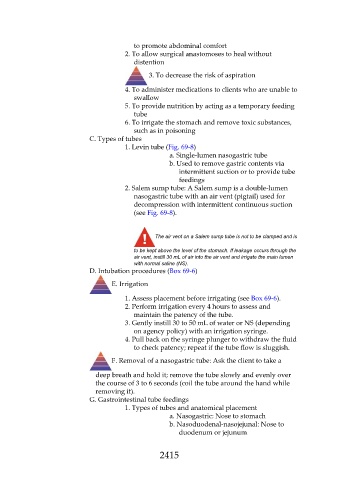Page 2415 - Saunders Comprehensive Review For NCLEX-RN
P. 2415
to promote abdominal comfort
2. To allow surgical anastomoses to heal without
distention
3. To decrease the risk of aspiration
4. To administer medications to clients who are unable to
swallow
5. To provide nutrition by acting as a temporary feeding
tube
6. To irrigate the stomach and remove toxic substances,
such as in poisoning
C. Types of tubes
1. Levin tube (Fig. 69-8)
a. Single-lumen nasogastric tube
b. Used to remove gastric contents via
intermittent suction or to provide tube
feedings
2. Salem sump tube: A Salem sump is a double-lumen
nasogastric tube with an air vent (pigtail) used for
decompression with intermittent continuous suction
(see Fig. 69-8).
The air vent on a Salem sump tube is not to be clamped and is
to be kept above the level of the stomach. If leakage occurs through the
air vent, instill 30 mL of air into the air vent and irrigate the main lumen
with normal saline (NS).
D. Intubation procedures (Box 69-6)
E. Irrigation
1. Assess placement before irrigating (see Box 69-6).
2. Perform irrigation every 4 hours to assess and
maintain the patency of the tube.
3. Gently instill 30 to 50 mL of water or NS (depending
on agency policy) with an irrigation syringe.
4. Pull back on the syringe plunger to withdraw the fluid
to check patency; repeat if the tube flow is sluggish.
F. Removal of a nasogastric tube: Ask the client to take a
deep breath and hold it; remove the tube slowly and evenly over
the course of 3 to 6 seconds (coil the tube around the hand while
removing it).
G. Gastrointestinal tube feedings
1. Types of tubes and anatomical placement
a. Nasogastric: Nose to stomach
b. Nasoduodenal-nasojejunal: Nose to
duodenum or jejunum
2415

